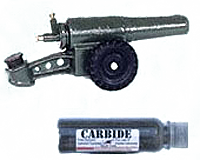Carbide Cannon
It came on Good Friday.A serious, cast-iron cannon replica.
Second biggest in the catalog.
I opened the tube of ammo:
Ahh, Calcium Carbide.
The silvery grains
smelled like a machine shop.
A carbide cannon works like this:
you put water in the bottom.
You pour in some grains,
lock the breach,
the grains hit the water and
fizz, making acetolene gas.1
I listened for the joyous fizz,
then pushed the pin:
spark + gas = ignition: blam
A perfect bullwhip CRACK
knocked the air in half,
then grumbled and rolled
half way around Beaver Lake.
Stop that, ordered my dad.
Why?
It's Good Friday.
No explosions until three oclock.
What happens if I do,
good friday goes bad?
But he'd gone back inside for a refill.
Then I noticed my grinning brother
hiding behind a tree.
Instantly I knew
he would order the bigger model,
the biggest one in the catalog,
the cannon with the chrome finish barrel,
which barrel is held in place with screws,
screws,
a frivolous showboat of a cannon,
not the svelte, unibody lady I had,
just bigger,
facts appreciable only by us,
while the others Ooh and Ahh
over my brother's tin chrome charade,
his leaky tube of gas with screws,
his over-the-top boondoggle
with its bang, bang, you're dead delivery,
our dad by then having acquiesced,
unsung me having made it all possible.
© J Ritter
1. 2(C2H2) + 5(O2) -> 4(CO2) + 2(H2O)


